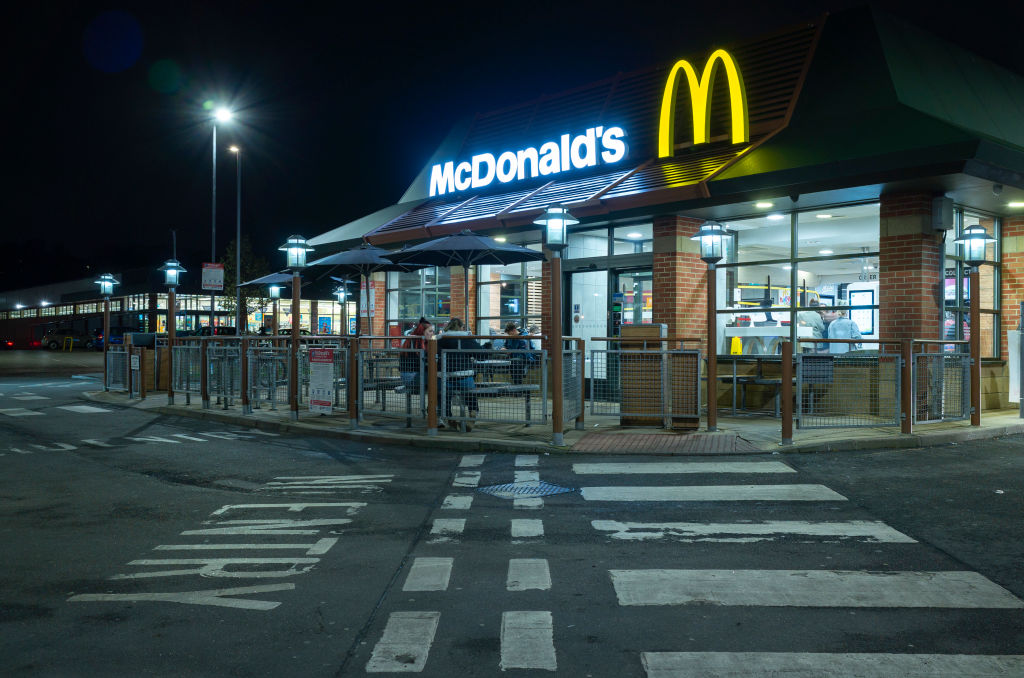A Night to Remember
If you’re going to eat McDonald’s, why not eat at McDonald’s?

While I have not yet sauntered into my local Steak ’n Shake to judge the purported superiority of beef tallow-drenched French fries, I have not been idle in my ongoing, apparently lifelong, survey of America’s fast-food offerings.
One night last week, I crossed the threshold of an area McDonald’s—not to place an order to go, as I sometimes do in the faint hope that my order be better understood face-to-face than over the intercoms, which are unimproved since the days of Wayne’s World. No, I swung open the doors to the Golden Arches with the full intention of, for the first time in some years, ordering and consuming a meal on the premises. What a concept!
Permit me to reminiscence for a moment. When I was growing up, McDonald’s was as much a destination as any of the other fast-food or fast-casual restaurants my family frequented, such as Shoney’s or Cracker Barrel. To be sure, we did avail ourselves of the McDonald’s drive-thru to take meals home, but when I requested to go to McDonald’s, I was requesting to go to McDonald’s—literally and seriously. I was not asking to be driven to McDonald’s, have an order placed on my behalf, and then have the order conveyed back to where we began (home). Such an expedition does not count as a trip, which carries the implication of a destination, so much as a ride, which is characterized by never getting out of the car. No, what I sought as a first- and second-grader was a full-fledged excursion to McDonald’s: an order placed at the counter, received on a plastic tray, and enjoyed while seated at plastic tables and chairs among other friendly families.
For far too many present-day McDonald’s patrons, however, not getting out of the car—never getting out of the car—seems to be precisely the point: The fast-food drive-thru lane has become not a matter of convenience—say, something to be used by car poolers in need of a caffeinated pick-me-up—but the de facto means by which most fast-food meals are acquired.
This is regrettable.
First, while I am well aware that the cuisine at McDonald’s is not fine dining on the order of my local French bistro (a high bar in a throbbing, worldly metropolis like Columbus, Ohio), their offerings are in no way enhanced by being packaged in sacks and driven home. To the contrary, my main motivation for eating at McDonald’s last week was to test the hypothesis that their food is superior when consumed in a non-lukewarm or wilted state. I can now affirm that my 9-year-old self was not wrong: The fries are far tastier when traveling the distance from deep-fryer to table rather than deep-fryer to car to front door to table—even without beef tallow.
Yet, on the weeknight I chose to dine in at McDonald’s, I was one of exactly two people who was doing so—the other was my brother. Apart from us, the customers who streamed in were either picking up their own orders or picking up orders on behalf of others. Notwithstanding the late hour at which I chose to have my dinner, I could not help but wonder why so many people were willing to drive to a McDonald’s but not willing to eat at a McDonald’s. Yes, I realize it is called fast food, but the inconvenient truth is that no actual time is saved when taking food home rather than eating the food there: The driver still has to travel to and from the restaurant, and the food still has to be eaten.
Subscribe Today
Get daily emails in your inbox
Alas, I fear that the reliance on the fast-food drive-thru to the exclusion of the fast-food dining room is another symptom of Americans’ tendency to cordon themselves off into silos. Even prior to the pandemic, we were becoming a population more committed to solitude than socialization. We buy things online, we prefer streaming movies to watching them in a multiplex, and we would rather scrutinize the images on a handheld phone than attend a concert, a play, or an art exhibition.
By the same token, many Americans are evidently perfectly content with unappetizingly cooled-down or melted food so long as it is devoured in the privacy of their living quarters—or, in some cases, in the quiet desolation of their cars. I am forever astonished at the number of YouTube fast-food reviewers who conduct their taste tests in the confines of their automobiles. Between the sonically enclosed space, which magnifies the sound of every chew, and the inevitable accumulation of crumbs, there could be few places gloomier to have any sort of meal, let alone one to be commemorated in digital video eternity. This is a sign of a nation turning inward—a people willing to make the trek to acquire a sack of food only to retreat, like hoarders, back to their safe spaces to consume and report back on it.
You can bet that when I finally do try those beef-tallow spuds, I hope to do so in the welcome company of other Make America Healthy Again adherents. What, after all, is healthier than sharing a meal with others?